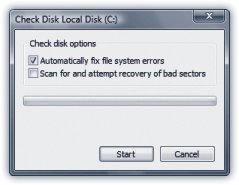20.3. Hard Drive Checkups: All Versions Every time you shut down the computer, Windows tidies up, ensuring all files are saved properly on the drive. When all is well, Windows turns off the machine. (All Vista-compatible PCs can turn themselves off; the days of messages telling you that, "It is now safe to turn off your computer" are over.) The time that elapses between your Turn Off Computer command and the actual power-down moment is the "tidying up" period. But sometimes, thanks to a system crash, power outage , or toddler playing with your surge suppressor , your computer gets turned off without warningand without the usual shutdown checks. In the olden days, way back even before Windows XP, restarting the PC after such a dirty shutdown automatically ran a program called ScanDisk, a utility designed to detect and, when possible, repair drive damage that may have occurred as a result of an improper shutdown. ScanDisk doesn't exist in Windows Vista, but its functions have been reincarnated. You get to this feature by right-clicking the icon of the hard drive you want to check (in the Computer window). From the shortcut menu, choose Properties; click the Tools tab, and click Check Now. Authenticate yourself (page 191).
Note: Geeks fondly refer to the feature described here as chkdsk (apparently named by someone with no vowels on his keyboard). You can also get to it by typing chkdsk into the Start menu's Search box. But the method described here is much better-looking.
As shown in Figure 20-3, a box appears, offering two options: -
Automatically fix file system errors . Clearly, you want this option turned on, so that any problems Windows finds are taken care of automatically.  | Figure 20-3. Checking your disk for errors regularly will go a long way toward making sure that your files won't get corrupted. If you use the "fix file errors" option, the check occurs at the next startup; the "scan" option goes into effect immediately . | |
Note: Even though the button you clicked was called Check Now, Vista cannot, in fact, check for errors now; that'd be like a surgeon operating on herself. When you click Start, a message cheerfully informs you that Windows will be happy to run this error check the next time it starts up. And indeed it will. Click "Schedule disk check" to make it so.
-
Scan for and attempt recovery of bad sectors . If you turn on this option, whenever the scan finds a damaged section of a drive, it moves any files located there elsewhere on the drive. Then the program surrounds that hard-disk area with the digital equivalent of a yellow "Police LineDo Not Cross" tape, so that Windows won't use the damaged area for storing files in the future. FREQUENTLY ASKED QUESTION
When Good Drives Go Bad | | I was surprised when the Check Disk dialog box found some problems with my hard drive. I don't understand what could have gone wrong. I treat my PC with respect, talk to it often, and never take it swimming. Why did my hard drive get flaky? All kinds of things can cause problems with your hard drive, but the most common are low voltage, power outages, voltage spikes, and mechanical problems with the drive controller or the drive itself. An inexpensive gadget called a line conditioner (sold at computer stores) can solve the low-voltage problem. A more expensive gizmo known as an Uninterruptible Power Supply (UPS) maintains enough backup battery power to keep your computer going when the power goes out completelyfor a few minutes, anyway, so that you can shut down the computer properly. The more expensive models have line conditioning built in. A UPS is also the answer to power outages, if they're common in your area. Voltage spikes are the most dangerous to your PC. They frequently occur during the first seconds when the power comes back on after a power failure. A surge suppressor is the logical defense here. But remember that the very cheap devices often sold as surge suppressors are actually little more than extension cords. Furthermore, some of the models that do provide adequate protection are designed to sacrifice themselves in battle. After a spike, you may have to replace them. If you care about your computer (or the money you spent on it), buy a good surge suppressor, at the very least. The best ones come with a guarantee that the company will replace your equipment (up to a certain dollar value) if the unit fails to provide adequate protection. |
When you've made your choice, click Start. If you selected only the "Scan" option, the procedure begins immediately; otherwise , the test is performed at the next startup. |
